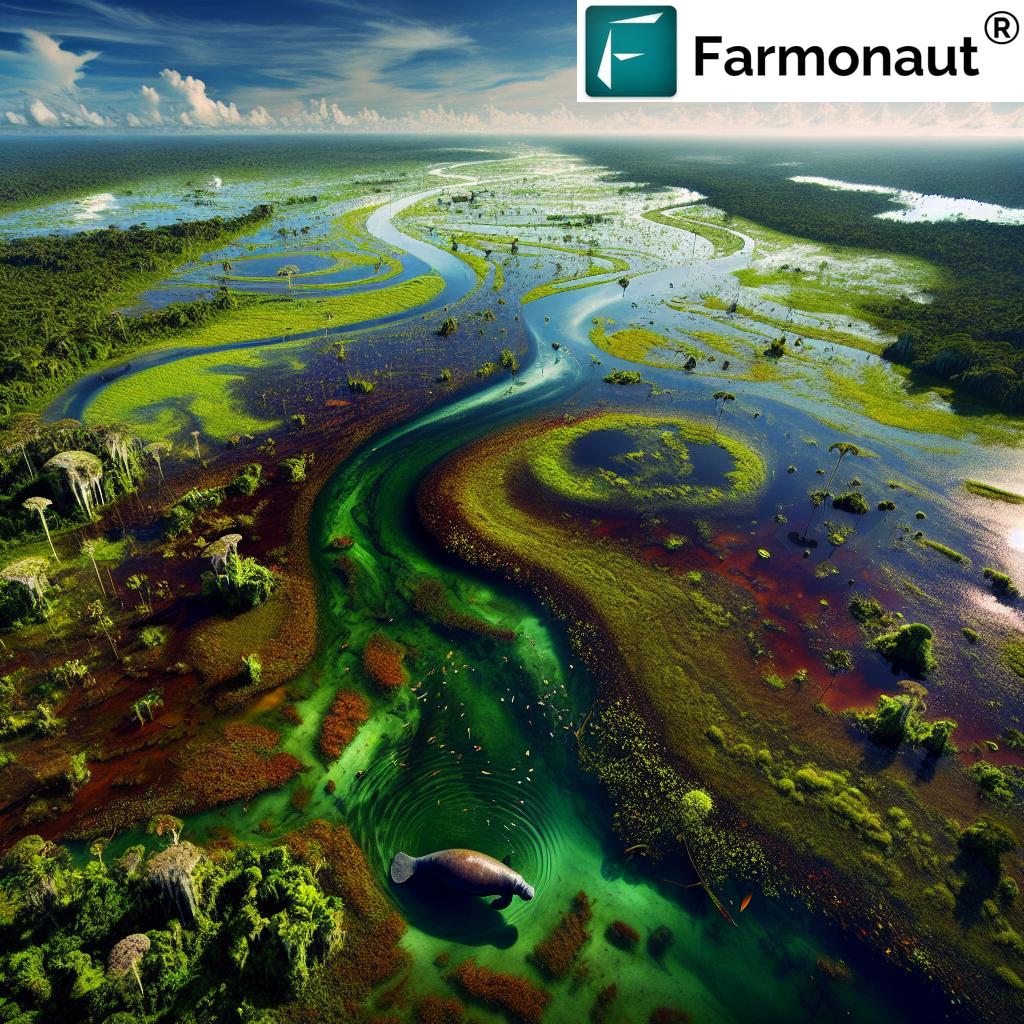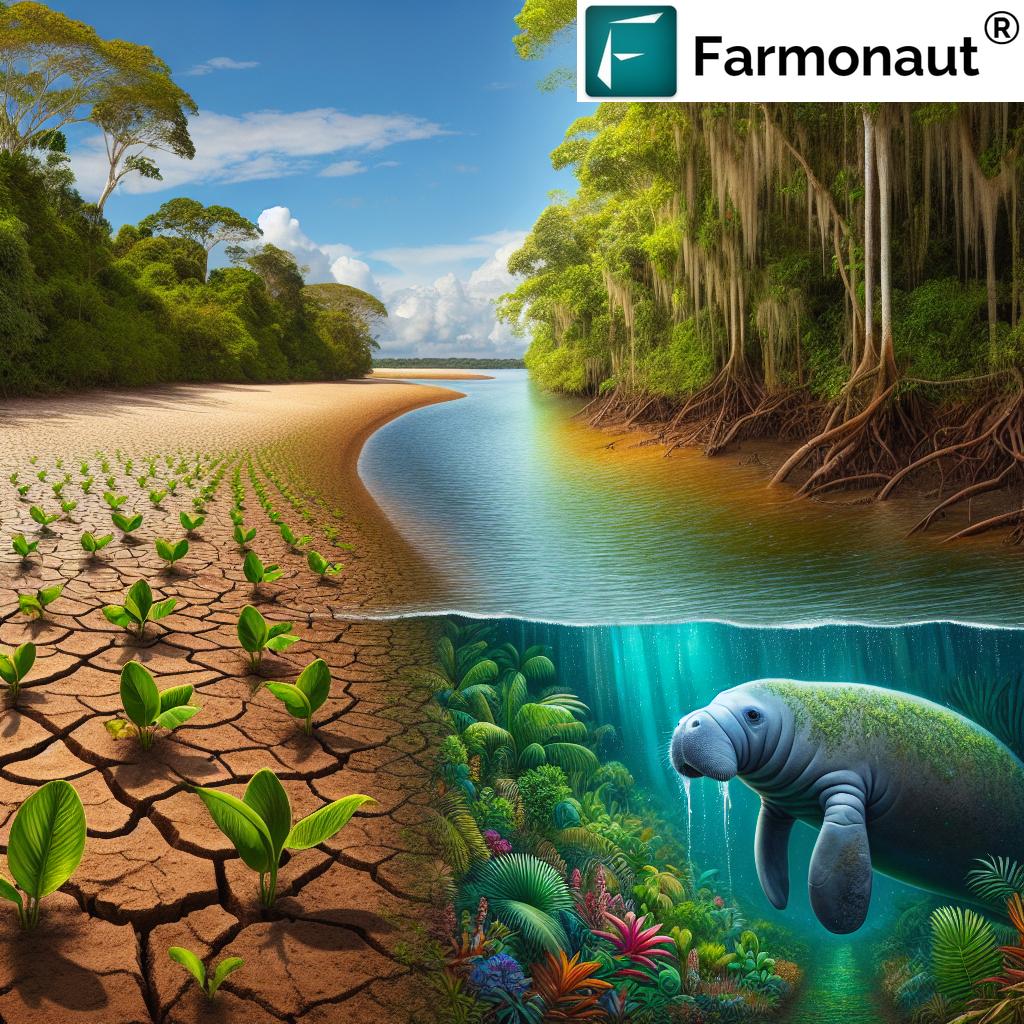Amazonian Manatees: Nature’s Unsung Heroes in Rainforest Seed Dispersal and Biodiversity Conservation
In the heart of the Amazon rainforest, a remarkable story of ecological interconnectedness is unfolding. The Amazonian manatee (Trichechus inunguis), often overlooked in discussions of rainforest biodiversity, has emerged as a crucial player in the complex web of seed dispersal and nutrient cycling. As we delve into this fascinating discovery, we’ll explore how these gentle giants contribute to the health and resilience of one of Earth’s most vital ecosystems.

“Amazonian manatees can transport viable seeds across vast distances, potentially covering hundreds of kilometers during seasonal floods.”
At Farmonaut, we recognize the importance of understanding complex ecosystem interactions for developing innovative agritech solutions that promote conservation and sustainable food production in tropical environments. Our satellite-based farm management solutions, accessible via  ,
,  , and
, and  , aim to bridge the gap between ecological preservation and agricultural productivity.
, aim to bridge the gap between ecological preservation and agricultural productivity.
The Groundbreaking Discovery
In the pristine waters of Lake Amanã, Brazil, biologist Michelle Guterres made a discovery that would challenge long-held assumptions about Amazonian manatees. During her research, Guterres found something extraordinary: manatee feces containing germinating seeds. This groundbreaking observation confirmed that these aquatic mammals play a vital role in seed dispersal, contributing to the migration of various plant species across the Amazon basin.
For years, the idea that manatees could aid in seed dispersal was merely speculative. Previous studies had failed to find viable seeds in manatee fecal samples, leading many researchers to dismiss the possibility. However, nature had a surprise in store.
A Drought’s Silver Lining
The severe drought of 2023 provided an unexpected opportunity for Guterres and her team. As water levels in Lake Amanã dropped to a mere 20 centimeters, vast stretches of beach were exposed, revealing a treasure trove of manatee feces. This rare occurrence allowed researchers to collect an unprecedented 96 fecal samples from the shores.
The results were astounding. Of the 96 samples collected, 19 contained germinating seeds. In total, researchers identified 2,033 seeds, with 556 of them viable. This evidence was robust enough to conclusively validate the hypothesis that manatees contribute significantly to seed dispersal in their habitat.
Manatees: Nature’s Floating Gardens
Guterres’s work illuminates the ecological significance of manatees, particularly during the seasonal flooding and drought cycles characteristic of Amazonian river systems. These cycles profoundly influence plant distribution and seed dispersal mechanisms, often facilitated by the movement of water and aquatic life.
While fish have long been recognized as seed dispersers in aquatic environments, the role of the much larger manatee introduces a new dynamic to this process. Manatees consume substantial amounts of aquatic vegetation daily and can transport seeds over considerable distances. Some manatees have been recorded traveling up to 115 kilometers (71 miles), making them potential long-distance seed couriers.
“A single Amazonian manatee can consume up to 50 kg of aquatic plants daily, contributing significantly to nutrient cycling in the rainforest.”
Nature’s Fertilizer Factory
Beyond their role as seed dispersers, manatees contribute essential nutrients to aquatic environments. Their feces act as a natural fertilizer, enhancing the growth potential of the seeds they disperse. This dual function of seed transport and nutrient provision makes manatees integral to maintaining biodiversity in both nutrient-rich floodplains and nutrient-poor igapós (blackwater-flooded forests).
The migratory habits of manatees reflect an intricate relationship with these contrasting environments. Their movements between nutrient-rich and nutrient-poor areas facilitate a crucial transfer of resources, underscoring the importance of their preservation for maintaining ecological balance across diverse Amazonian habitats.

Threats to Amazonian Manatees
Despite their ecological importance, Amazonian manatees face significant threats. Listed as a vulnerable species, they are primarily endangered by illegal hunting practices and habitat degradation, exacerbated by climate change. The risk of extinction becomes particularly acute during drought conditions when manatees congregate in shallower waters, making them more susceptible to hunters.
Guterres emphasizes the urgent need for conservation efforts, advocating for educating local communities about the ecological roles of manatees. These gentle giants are vital for sustaining the health of the Amazonian ecosystem, and their protection is crucial for maintaining the delicate balance of this complex environment.
The Ripple Effect of Manatee Conservation
The findings underscore the critical nature of protecting the manatee population. Their presence is integral not only to the biodiversity of the Amazon but also to the communities that rely on these ecosystems for their livelihoods. As researcher Maria Tereza Piedade states, safeguarding the manatee represents a broader commitment to preserving the intricate and interconnected tapestry of life that characterizes the Amazon Basin.
At Farmonaut, we understand the importance of these ecological connections in developing sustainable agricultural practices. Our API and API Developer Docs provide tools for monitoring and analyzing environmental changes that affect both wildlife and agriculture.
Amazonian Manatee Impact on Ecosystem
| Ecosystem Aspect | Manatee Contribution | Estimated Impact | Conservation Importance |
|---|---|---|---|
| Seed Dispersal | Transport viable seeds across long distances | High | Critical |
| Nutrient Cycling | Feces act as natural fertilizer | High | Very Important |
| Aquatic Plant Growth | Promote growth through grazing and nutrient provision | Medium | Important |
| Biodiversity Support | Maintain plant diversity through seed dispersal | High | Critical |
| Floodplain Health | Transfer nutrients between rich and poor areas | Medium | Very Important |
Climate Change and Its Impact on Manatees and Agriculture
The threats facing Amazonian manatees are closely linked to broader environmental challenges, particularly climate change. As global temperatures rise, the Amazon Basin experiences more frequent and severe droughts, altering the delicate balance of aquatic ecosystems. These changes not only affect manatees but also have significant implications for agriculture in the region.
- Changing Water Levels: Fluctuating water levels due to climate change can disrupt manatee migration patterns and feeding habits. Similarly, these changes affect agricultural practices, particularly in floodplain areas where farming is closely tied to seasonal flooding cycles.
- Habitat Fragmentation: As droughts become more common, water bodies may become isolated, trapping manatees in shrinking pools. This fragmentation also impacts agricultural lands, potentially leading to soil degradation and reduced crop yields.
- Altered Plant Communities: Changes in temperature and rainfall patterns can shift the composition of aquatic and terrestrial plant communities. This affects both manatee food sources and agricultural crop viability.
Understanding these interconnections is crucial for developing sustainable agricultural practices that coexist with and support natural ecosystems. Farmonaut’s satellite-based monitoring systems can play a vital role in tracking these environmental changes, helping both conservationists and farmers adapt to evolving conditions.
The Role of Technology in Conservation and Sustainable Agriculture
As we confront the challenges of protecting species like the Amazonian manatee while ensuring food security, technology emerges as a crucial ally. Farmonaut’s advanced satellite-based solutions offer invaluable tools for both conservation efforts and sustainable agricultural practices:
- Habitat Monitoring: Our satellite imagery can track changes in aquatic environments, helping researchers monitor manatee habitats and migration patterns.
- Crop Health Assessment: The same technology used to observe aquatic ecosystems can be applied to agricultural lands, allowing farmers to optimize their practices and reduce environmental impact.
- Water Resource Management: By providing data on soil moisture and water availability, our tools help in managing water resources more efficiently, benefiting both wildlife and agriculture.
- Climate Change Adaptation: Real-time data and predictive analytics enable both conservationists and farmers to adapt to changing climate conditions more effectively.
By leveraging these technological advancements, we can work towards a future where conservation and agriculture are not competing interests but complementary efforts in maintaining ecological balance.
Sustainable Agriculture Practices Inspired by Manatees
The study of Amazonian manatees and their role in ecosystem health offers valuable insights for developing sustainable agricultural practices. Here are some lessons we can apply:
- Integrated Nutrient Management: Just as manatees contribute to nutrient cycling in aquatic environments, farmers can adopt integrated nutrient management practices that mimic natural processes, reducing reliance on synthetic fertilizers.
- Crop Diversity: The diversity of seeds dispersed by manatees underscores the importance of maintaining crop diversity in agricultural systems to enhance resilience and soil health.
- Water Conservation: Manatees’ adaptations to changing water levels highlight the importance of efficient water management in agriculture, especially in regions prone to drought.
- Habitat Corridors: Creating and maintaining habitat corridors in agricultural landscapes can support biodiversity and ecosystem services, much like how manatees connect different aquatic habitats.
At Farmonaut, we integrate these principles into our advisory systems, helping farmers implement practices that are both productive and ecologically sound.
The Way Forward: Balancing Conservation and Agriculture
The discovery of Amazonian manatees’ role in seed dispersal and ecosystem health presents both challenges and opportunities. As we work to protect these remarkable creatures and the habitats they support, we must also consider how to sustainably meet the growing demand for food production. This balance is at the heart of Farmonaut’s mission.
By leveraging advanced technology and data-driven insights, we can:
- Implement precision agriculture techniques that maximize yields while minimizing environmental impact
- Develop early warning systems for environmental changes that affect both wildlife and crops
- Create more effective conservation strategies based on real-time ecosystem data
- Educate farmers and communities about the importance of biodiversity in maintaining agricultural productivity
The story of the Amazonian manatee reminds us that in nature, everything is connected. As we strive to feed a growing global population, we must do so in a way that preserves the intricate ecosystems that support all life on Earth. Through innovative technology and a commitment to sustainability, we can create a future where agriculture and conservation work hand in hand, ensuring a healthy planet for generations to come.
Farmonaut’s Commitment to Sustainable Agriculture
At Farmonaut, we’re dedicated to bridging the gap between cutting-edge technology and sustainable farming practices. Our suite of tools and services is designed to empower farmers with the information they need to make environmentally conscious decisions while optimizing their yields. Here’s how we’re contributing to a more sustainable future:
- Precision Agriculture: Our satellite-based crop monitoring system allows farmers to precisely target their interventions, reducing unnecessary use of water, fertilizers, and pesticides.
- AI-Powered Insights: The Jeevn AI advisory system provides personalized recommendations that take into account local environmental conditions, promoting practices that are both productive and sustainable.
- Resource Optimization: Our fleet and resource management tools help agribusinesses reduce their carbon footprint by optimizing logistics and machinery use.
- Environmental Impact Tracking: With our carbon footprinting feature, businesses can monitor and actively work to reduce their environmental impact.
By providing these advanced tools, we aim to create a future where agricultural productivity goes hand in hand with environmental stewardship. Just as the Amazonian manatee plays a crucial role in maintaining ecosystem balance, we believe technology can play a pivotal role in balancing human needs with environmental conservation.
Frequently Asked Questions
- Q: How do Amazonian manatees contribute to seed dispersal?
A: Amazonian manatees consume aquatic plants and transport seeds through their digestive system. They then defecate these seeds in new locations, often far from the original plant, helping to spread plant species across the Amazon basin. - Q: Why is the discovery of manatees as seed dispersers important?
A: This discovery highlights the crucial role manatees play in maintaining biodiversity and ecosystem health in the Amazon. It underscores the interconnectedness of species and the importance of conservation efforts. - Q: How does climate change affect Amazonian manatees?
A: Climate change leads to more frequent and severe droughts, altering water levels in the manatees’ habitats. This can trap manatees in shrinking water bodies, making them more vulnerable to hunting and reducing their ability to access food sources. - Q: What can be done to protect Amazonian manatees?
A: Protection efforts include combating illegal hunting, preserving and restoring manatee habitats, educating local communities about the importance of manatees, and implementing policies to mitigate the effects of climate change. - Q: How does Farmonaut contribute to conservation efforts?
A: While Farmonaut doesn’t directly engage in manatee conservation, our satellite-based monitoring tools and data analytics can help researchers track environmental changes affecting manatee habitats. This information can be crucial for developing effective conservation strategies. - Q: Can sustainable agriculture practices help protect species like the Amazonian manatee?
A: Yes, sustainable agriculture practices can reduce environmental pressures on natural habitats. By optimizing resource use and minimizing pollution, sustainable farming can help maintain the health of aquatic ecosystems that manatees depend on. - Q: How does Farmonaut’s technology support sustainable agriculture?
A: Farmonaut’s satellite-based crop monitoring, AI advisory systems, and resource management tools help farmers optimize their practices, reduce waste, and minimize environmental impact, contributing to more sustainable agricultural systems.
Conclusion
The discovery of Amazonian manatees as key players in seed dispersal and nutrient cycling in the Amazon rainforest underscores the intricate connections within ecosystems. It reminds us that every species, no matter how unassuming, can play a vital role in maintaining the health and biodiversity of our planet.
As we face the challenges of climate change and increasing demand for agricultural production, the story of the Amazonian manatee offers valuable lessons. It highlights the need for a holistic approach to conservation and sustainable development, where the protection of natural habitats goes hand in hand with innovative agricultural practices.
At Farmonaut, we’re committed to supporting this balance through our advanced agricultural technology solutions. By providing farmers and researchers with powerful tools for monitoring and analyzing environmental data, we aim to contribute to a future where human activities and natural ecosystems can thrive together.
The journey towards sustainable agriculture and effective conservation is ongoing, and it requires the collaboration of scientists, technologists, farmers, and policymakers. As we continue to uncover the secrets of our natural world, like the surprising role of manatees in seed dispersal, we’re reminded of the importance of preserving and studying these complex ecosystems.
Let the story of the Amazonian manatee inspire us to look deeper, think more holistically, and act more responsibly in our stewardship of the Earth’s resources. Together, we can work towards a future where the wonders of nature, like the gentle manatees of the Amazon, continue to play their crucial roles in maintaining the health and diversity of our planet for generations to come.



